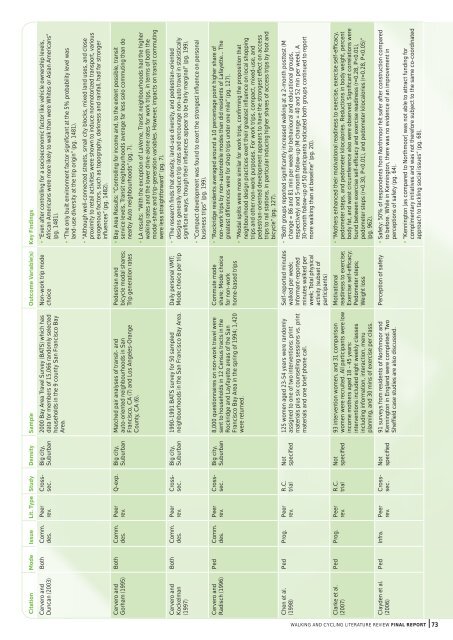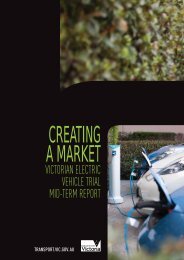Walking and Cycling International Literature Review - Department of ...
Walking and Cycling International Literature Review - Department of ...
Walking and Cycling International Literature Review - Department of ...
Create successful ePaper yourself
Turn your PDF publications into a flip-book with our unique Google optimized e-Paper software.
Citation Mode Issue Lit. Type Study Density Sample Outcome Variable(s) Key Findings<br />
Cervero <strong>and</strong><br />
Duncan (2003)<br />
Both Comm.<br />
des.<br />
Peer<br />
rev.<br />
Big city,<br />
Suburban<br />
2000 Bay Area Travel Survey (BATS) which has<br />
data for members <strong>of</strong> 15,066 r<strong>and</strong>omly selected<br />
households in the 9 county San Francisco Bay<br />
Area.<br />
Non-work trip mode<br />
choice<br />
• “Even after controlling for a socioeconomic factor like vehicle ownership levels,<br />
African Americans were more likely to walk than were Whites or Asian Americans”<br />
(pg. 1481).<br />
• “The only built environment factor significant at the 5% probability level was<br />
l<strong>and</strong>-use diversity at the trip origin” (pg. 1481).<br />
• “Although well-connected streets, small city blocks, mixed l<strong>and</strong> uses, <strong>and</strong> close<br />
proximity to retail activities were shown to induce nonmotorized transport, various<br />
exogenous factors, such as topography, darkness <strong>and</strong> rainfall, had far stronger<br />
influences” (pg. 1482).<br />
Cervero <strong>and</strong><br />
Gorham (1995)<br />
Both Comm.<br />
des.<br />
Peer<br />
rev.<br />
Q-exp. Big city,<br />
Suburban<br />
Matched pair analyses <strong>of</strong> transit- <strong>and</strong><br />
auto-oriented neighbourhoods in San<br />
Francisco, CA (7) <strong>and</strong> Los Angeles-Orange<br />
County, CA (6).<br />
Pedestrian <strong>and</strong><br />
bicycle modal shares;<br />
Trip generation rates<br />
• Bay Area Results: “Controlling for income <strong>and</strong>, to the extent possible, transit<br />
service levels, Transit neighbourhoods average far less solo commuting than do<br />
nearby Auto neighbourhoods” (pg. 7).<br />
• LA results: “With the exception <strong>of</strong> LaVerne, Transit neighbourhoods had the higher<br />
walking rates <strong>and</strong> the lower drive-alone rates for work trips, in terms <strong>of</strong> both the<br />
modal-share <strong>and</strong> trip-generation variables. However, impacts on transit commuting<br />
were less straightforward” (pg. 7).<br />
Cervero <strong>and</strong><br />
Kockelman<br />
(1997)<br />
Both Comm.<br />
des.<br />
Peer<br />
rev.<br />
Big city,<br />
Suburban<br />
1990-1991 BATS survey for 50 sampled<br />
neighbourhoods in the San Francisco Bay Area.<br />
Daily personal VMT;<br />
Mode choice per trip<br />
• “The research finds that density, l<strong>and</strong>-use diversity, <strong>and</strong> pedestrian-oriented<br />
designs generally reduce trip rates <strong>and</strong> encourage non-auto travel in statistically<br />
significant ways, though their influences appear to be fairly marginal” (pg. 199).<br />
• “Compact development was found to exert the strongest influence on personal<br />
business trips” (pg. 199).<br />
Cervero <strong>and</strong><br />
Radisch (1996)<br />
Ped Comm.<br />
des.<br />
Peer<br />
rev.<br />
Big city,<br />
Suburban<br />
8,000 questionnaires on non-work travel were<br />
sent to households in 12 Census tracts in the<br />
Rockridge <strong>and</strong> Layfayette areas <strong>of</strong> the San<br />
Francisco Bay Area in the spring <strong>of</strong> 1994; 1,420<br />
were returned.<br />
Commute mode<br />
share; Mode choice<br />
for non-work<br />
home-based trips<br />
• “Rockridge residents averaged around a 10 percentage point higher share <strong>of</strong><br />
non-work trips by non-automobile modes than did residents <strong>of</strong> Lafayette... The<br />
greatest differences were for shop trips under one mile” (pg. 127).<br />
• “Modal splits were more similar for work trips, confirming the proposition that<br />
neighbourhood design practices exert their greatest influence on local shopping<br />
trips <strong>and</strong> other non-work purposes. For work trips, compact, mixed-use, <strong>and</strong><br />
pedestrian-oriented development appears to have the strongest effect on access<br />
trips to rail stations, in particular inducing higher shares <strong>of</strong> access trips by foot <strong>and</strong><br />
bicycle” (pg. 127).<br />
Chen et al.<br />
(1998)<br />
Ped Prog. Peer<br />
rev.<br />
R.C.<br />
trial<br />
Not<br />
specified<br />
125 women aged 23-54 years were r<strong>and</strong>omly<br />
assigned to one <strong>of</strong> two interventions: print<br />
materials plus six counselling sessions vs. print<br />
materials <strong>and</strong> one brief phone call.<br />
Self-reported minutes<br />
walked per week;<br />
Informant-reported<br />
minutes walked per<br />
week; Total physical<br />
activity (subset <strong>of</strong><br />
participants)<br />
• “Both groups reported significantly increased walking at a 2-month posttest (M<br />
change = 86 <strong>and</strong> 81 min per week for behavioural <strong>and</strong> educational groups,<br />
respectively) <strong>and</strong> 5-month follow-up (M change = 40 <strong>and</strong> 52 min per week). A<br />
30-month follow-up <strong>of</strong> 50 participants indicated both groups continued to report<br />
more walking than at baseline” (pg. 20).<br />
Clarke et al.<br />
(2007)<br />
Ped Prog. Peer<br />
rev.<br />
R.C.<br />
trial<br />
Not<br />
specified<br />
93 intervention women, <strong>and</strong> 31 comparison<br />
women were recruited. All participants were low<br />
income mothers aged 18 - 45 years:<br />
interventions included eight weekly classes<br />
including information, interaction, menu<br />
planning, <strong>and</strong> 30 mins <strong>of</strong> exercise per class.<br />
Motivational<br />
readiness to exercise;<br />
Exercise self-efficacy;<br />
Pedometer steps;<br />
Weight loss<br />
• “Mothers enhanced their motivational readiness to exercise, exercise self-efficacy,<br />
pedometer steps, <strong>and</strong> pedometer kilocalories. Reductions in body weight, percent<br />
body fat, <strong>and</strong> waist circumference also were observed. Significant correlations were<br />
found between exercise self-efficacy <strong>and</strong> exercise readiness (r=0.28, P

















